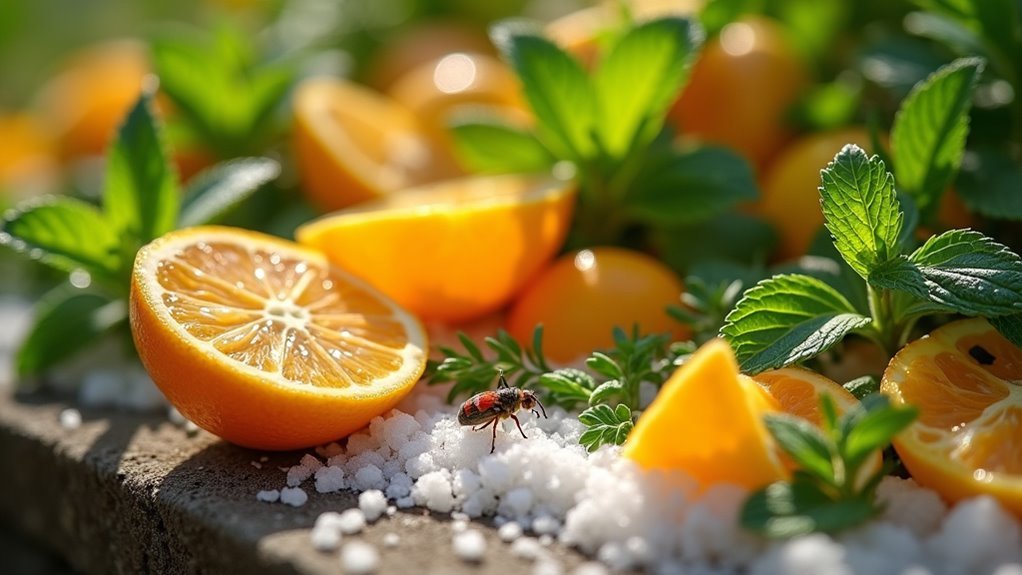You can create citrus peel barriers by placing fresh orange or lemon peels around your plants’ base, though they contain less than 1.2% d-limonene, which limits their effectiveness against most pests. Replace the peels every 2-3 days since they lose potency quickly when dried. While citrus barriers may deter ants, they’re insufficient for aphids and could attract rodents or snails. Combining them with beneficial insects and physical barriers creates a more thorough natural pest management strategy.
Understanding How Citrus Peels Deter Garden Pests

While citrus peels contain volatile organic compounds like d-limonene that theoretically repel garden pests, their practical effectiveness falls short of most gardeners’ expectations.
You’ll find that fresh orange peels contain less than 1.2% limonene, which isn’t concentrated enough to effectively deter insects compared to commercial essential oils.
As these peels dry out, their scent dissipates rapidly, eliminating any potential pest repellent properties.
Rather than protecting your garden plants, citrus peels may actually attract unwanted visitors like rodents and snails, creating bigger problems than you started with.
Citrus peels scattered in gardens often backfire by luring rodents and snails instead of repelling harmful insects.
Experts recommend composting these peels instead, where they’ll enrich your soil rather than serving as ineffective barriers against pests.
Types of Citrus Peels Most Effective for Pest Control
When you’re choosing citrus peels for pest control, you’ll find that orange peels contain the highest levels of limonene, though they still fall short of the 1.2% concentration needed for reliable pest deterrence.
Lemon and lime peels contain even lower concentrations of essential oils, making them less effective than orange peels for repelling garden pests.
You should know that regardless of which citrus peel you select, the essential oil concentrations in fresh peels won’t provide the potency required for meaningful pest control results.
Orange Peel Effectiveness
Although citrus peels contain limonene—a compound known for pest-repelling properties—orange peels and other citrus varieties don’t pack enough of this natural insecticide to serve as effective garden pest control.
Orange peels contain less than 1.2% limonene, which isn’t sufficient for reliable pest repellent effectiveness. While the essential oils might initially deter some pests like ants through scent, this effectiveness quickly diminishes as the volatile compounds evaporate and peels dry out.
You’ll find limited scientific evidence supporting orange peels as a thorough pest control barrier. The temporary deterrent effect doesn’t justify relying on them for serious garden protection.
Instead, you’ll get better results by composting your citrus peels, which enriches soil and supports overall plant health—making your garden naturally more resilient against pest problems.
Lemon Vs Lime
If you’re determined to use citrus peels for pest control despite their limited effectiveness, lemon peels offer your best option among common varieties. Lemon peels contain higher concentrations of d-limonene compared to lime peels, making them more effective as a natural pest deterrent. Their essential oils release slowly, extending their longevity as barriers.
| Factor | Lemon Peels | Lime Peels |
|---|---|---|
| D-limonene Content | Higher concentration | Lower concentration |
| Oil Release Rate | Slower, longer-lasting | Faster, shorter duration |
| Pest Control Effectiveness | More effective | Less effective |
| Availability | Widely available | Readily available |
While lime peels can substitute in a pinch, they contain fewer active compounds. Compost both varieties before garden use to maximize nutrient benefits, as fresh peels provide minimal pest-repelling effects.
Essential Oil Concentrations
While citrus peels contain d-limonene and other essential oils, their concentrations rarely exceed 1.2% in fresh peels—far below the levels needed for effective pest control.
You’ll find that these essential oil concentrations become even more diluted when exposed to air, making citrus peels ineffective as a reliable pest repellent for your garden.
Commercial pest control products containing citrus oils are specifically formulated with much higher concentrations than what you’ll get from raw peels.
Once your citrus peels dry out, the volatile oils evaporate completely, eliminating any remaining pest-deterring properties.
Instead of relying on peels for pest control, you’re better off composting them to enhance your soil’s nutrient content while investing in proven pest management solutions.
Preparing and Processing Citrus Peels for Garden Use
Two key preparation methods can dramatically boost citrus peels’ effectiveness in your garden.
First, composting citrus peels enriches soil with nitrogen and nutrients while improving structure. Before adding peels to your compost pile, dry and grind them finely to accelerate decomposition and nutrient release.
Dry and grind citrus peels before composting to speed decomposition and maximize their nitrogen-rich soil benefits.
Second, use fresh peels immediately as a pest repellent since their volatile oils lose effectiveness once dried. Always source organic citrus peels to avoid introducing harmful pesticides to your soil.
After processing, you can spread orange peels around plant bases or incorporate them into seed starter pots. These biodegradable options boost nutrient availability for seedlings while providing natural protection.
Creating Strategic Barrier Placement Around Plants

You’ll maximize your citrus peel barrier’s effectiveness by identifying the ideal placement zones around each plant’s base and vulnerable areas.
Proper distance and spacing between peels creates a continuous deterrent while ensuring complete coverage without waste.
Establishing a consistent refresh schedule keeps your barriers potent as the citrus oils naturally dissipate over time.
Optimal Peel Placement Zones
Strategic placement of citrus peels around your plants creates an effective defense system against crawling garden pests. For ideal peel placement, position fresh citrus peels in a complete circle around each plant’s base, forming a protective barrier that deters ants and slugs.
Place peels close to plant stems where ground-traveling pests typically access your crops.
Choose shaded garden areas for your citrus barriers since direct sunlight quickly dries out the peels, reducing their pest-repelling effectiveness. Fresh peels work better than dried ones because their volatile oils remain active and potent.
You’ll need to refresh your citrus barriers regularly throughout the growing season by adding new peels or replacing dried ones. This consistent maintenance guarantees your natural defense system continues to repel garden pests effectively.
Distance and Spacing Guidelines
Although proper placement creates an effective barrier, the distance between citrus peels and your plants determines how well they’ll repel unwanted visitors. Position peels 6-12 inches around your plant’s base to create an effective deterrent zone.
For larger plants, use a ring formation rather than complete circles, which improves air circulation and prevents moisture buildup that attracts pests.
Maintain proper spacing between multiple barriers by keeping them 2-3 feet apart. This distance prevents overlap while ensuring each plant receives adequate protection. Strategic spacing also avoids attracting larger wildlife that might be drawn to concentrated peel areas.
Remember that fresh peels work best, so replace them every few days. This regular maintenance keeps your barriers effective and prevents the dried peels from losing their deterrent properties.
Barrier Refresh Schedule
Since citrus peels lose their potency within 72 hours, establishing a consistent refresh schedule guarantees your barriers maintain maximum deterrent strength.
You’ll need to replace citrus peels every two to three days before volatile oils evaporate completely. Monitor your barriers daily, checking for dried-out or decaying peels that compromise effectiveness.
Create calendar reminders for barrier refresh sessions to maintain consistency. During replacement, remove old peels completely before placing fresh ones around plant bases and high-activity pest zones.
Choose organic citrus peels exclusively to protect soil quality and plant health from harmful chemicals.
Your pest repellent system works best when combined with companion planting and insecticidal soap treatments. This multi-layered approach enhances overall garden protection while maintaining the natural barrier refresh cycle you’ve established.
Combining Citrus Peels With Other Natural Deterrents

While citrus peels offer solid pest-repelling benefits on their own, you’ll achieve far better results by combining them with complementary natural deterrents.
Create a powerful Natural Pest Repellent system by incorporating beneficial insects like ladybugs and lacewings alongside your citrus peels. These predatory insects will establish a balanced ecosystem that naturally controls pest populations while the peels provide additional deterrence.
Extract essential oils from citrus peels for stronger repellent effects when you need higher concentrations.
Plant trap crops near your protected areas to lure pests away from valuable plants. Install fine mesh netting or row covers for physical protection while peels act as chemical barriers.
Monitor pest activity regularly and adjust your combination of organic deterrents accordingly for superior results.
Maintaining and Refreshing Your Citrus Peel Barriers
Once you’ve established your citrus peel deterrent system, you’ll need to maintain it properly to keep those volatile oils working at peak effectiveness.
Replace your citrus peels every few days to guarantee they remain aromatic and functional as a pest repellent. Fresh peels work best since dried ones lose their potent oils quickly.
Fresh citrus peels maintain their aromatic pest-repelling oils better than dried ones, so replace your garden barriers every few days.
After rain or watering, check your barriers and refresh them immediately. The moisture reduces their effectiveness considerably.
If you’re using dried peels, crush or grind them to maximize surface area and release remaining essential oils.
Monitor your garden regularly for pest activity. If you notice pests still present, combine your citrus peels with other natural deterrents for better results.
Target Pests That Respond to Citrus Peel Repellents
Understanding which pests actually respond to citrus peel repellents helps you target your efforts effectively.
Ants show the strongest response to citrus peels because they dislike the d-limonene scent. You’ll find this compound naturally occurs in orange, lemon, and grapefruit peels, making them effective ant deterrents.
Aphids present a more challenging target. While citrus peels contain some repellent properties against these tiny insects, the concentration isn’t typically strong enough for reliable control. You’ll need higher d-limonene levels than what fresh peels provide.
However, be aware that citrus barriers can backfire by attracting unwanted visitors like raccoons and snails. These larger pests view the peels as food rather than a repellent, potentially creating bigger garden problems than the ones you’re trying to solve.
Alternative Natural Pest Control Methods When Citrus Fails
When citrus peels don’t deliver the pest control results you’re hoping for, several proven natural alternatives can step in to protect your garden.
While citrus peels actually work well for certain pests, you’ll need different strategies when they fall short.
These natural pest control methods offer reliable protection:
- Physical barriers – Cover plants with fine mesh netting or floating row covers to block insects completely.
- Strategic planting – Use crop rotation and trap crops to disrupt pest life cycles while encouraging beneficial insects through biodiversity.
- Organic treatments – Apply neem oil or insecticidal soap to target specific pests safely.
- Water spraying – Regularly hose down plants to dislodge aphids and spider mites without chemicals.
These alternatives protect plants effectively when citrus-based solutions aren’t enough.
Frequently Asked Questions
Do Citrus Peels Keep Bugs Away?
You shouldn’t rely on citrus peels to keep bugs away. They don’t contain enough active compounds like limonene, and their oils evaporate quickly, making them ineffective pest deterrents despite popular claims.
Do Citrus Peels Repel Rodents?
You can’t rely on citrus peels to repel rodents effectively. Scientific evidence doesn’t support their deterrent properties, and they may actually attract pests. Use proper sealing, traps, or professional services instead.
What Animals Do Citrus Peels Repel?
You’ll find citrus peels can deter ants and aphids due to d-limonene oils. However, they’re not effective against rodents and may actually attract raccoons, possums, and other larger animals to your garden.
How to Make Insect Repellent With Orange Peels?
Combine fresh orange peels with hot water in a spray bottle. Add a few drops of dish soap, shake well, and spray on plant leaves and stems where pests gather. Reapply after rain.
In Summary
You’ll find citrus peel barriers offer an eco-friendly solution that’s both cost-effective and sustainable for your garden. Don’t expect overnight results—you’ll need patience and consistency to see the full benefits. If citrus peels aren’t working for your specific pest problems, you’ve got plenty of other natural alternatives to try. Remember to refresh your barriers regularly and combine them with complementary deterrents for maximum effectiveness in protecting your plants.





Leave a Reply